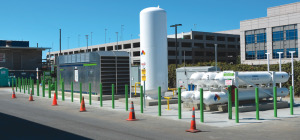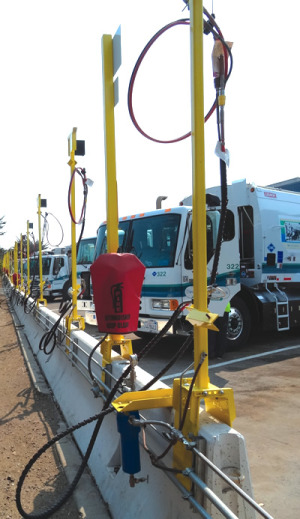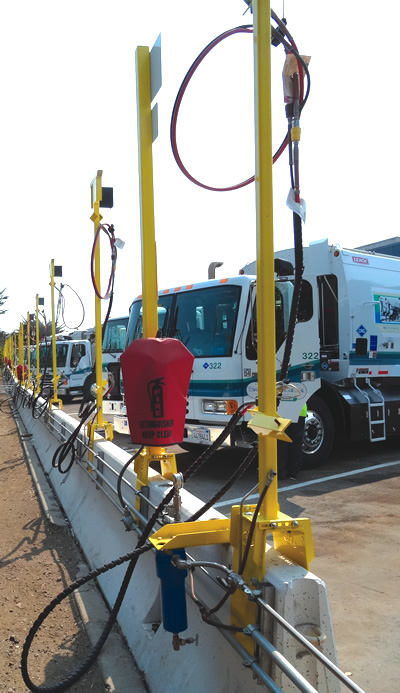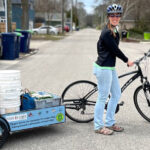A dry anaerobic digester, with two composting tunnels, was constructed at a transfer station to process 11,200 tons/year of source separated organics.
Nora Goldstein
BioCycle November 2014

The 11,200 tons/year system includes 8 modular digesters, 2 in-vessel composters and 2 materials receiving bays. Photos courtesy of SSFSC

The renewable CNG feeds into an existing Clean Energy fueling station and is blended with fossil natural gas.
South San Francisco Scavenger Company (SSFSC) and Blue Line Transfer, the facility that handles SSFSC’s recycling and disposal, expects to start cold commissioning of its dry anaerobic digestion system later this month. “That process takes four to six weeks, as long as everything is working well,” notes Doug Button, president of SSFSC/Blue Line Transfer. The fully enclosed facility is designed to process 11,200 tons/year of material, including food scraps and food soiled paper collected from businesses in the company’s service area, including South San Francisco, Brisbane, Millbrae, Colma and San Francisco International Airport. Biogas will be conditioned and compressed into fuel for collection vehicles.
Located on a one-quarter-acre footprint at the Blue Line Transfer station in South San Francisco, the system includes eight modular digesters and two in-vessel composting (IVC) tunnels, all supplied by Zero Waste Energy, LLC (ZWE), a California-based project development company with the North American license to the SMARTFERM high solids, dry fermentation anaerobic digestion and in-vessel composting (IVC) technologies developed by Eggersmann. “Our facility is similar in design to the Monterey Regional Waste Management District’s dry AD system in Marina, California (see “Solid Waste District Pilots Dry Fermentation Digester,” November 2013), but we had the modular units lengthened so more organics could be processed,” says Button. “Each digester has capacity of about 150 tons.” The digesters are manufactured in the U.S., and are transported by truck for installation.
SSFSC has been collecting yard trimmings and wood waste for about 20 years. About six years ago, the company starting collecting source separated commercial organics, and is launching a residential SSO program that will service about 20,000 households. “We’ve been collecting food scraps from commercial customers and sending them to a composting facility,” he explains. “One of our main customers is San Francisco International Airport, which diverts primarily postconsumer food waste. With the residential program, we are providing households with a food scraps pail, and they can empty that into their green waste carts. Compostable cups and plates are accepted, as well as soiled paper. We anticipate receiving about 50 tons/day of food scraps from the residential collection route.”
Receiving, Digestion, Fuel
Incoming feedstocks are tipped into a negatively aerated mixing bay that is 20-feet wide, 50-feet long and 28-feet high — about the size of two modular digesters. Visible contaminants are removed by hand. Ground yard trimmings are added as needed to attain a 50:50 mix of food scraps to green waste. “We need the yard waste for porosity,” notes Button. “We may be able to go as high as 80 percent food waste as that will increase gas production.”

Over half of South San Francisco Scavenger Company’s fleet of collection trucks is equipped with CNG engines.
The percolate tank, which captures and recirculates percolate (microorganism-rich liquid) through the digester contents, is heated by a boiler that burns “fugitive” biogas, i.e., the low end or tail gases (e.g., butane, propane and carbon dioxide) that often are flared. Roughly 70 percent of the biogas produced will be used for CNG; fugitive biogas makes up the balance.
Organics remain in the digester modules for 21 days, after which the digestate is transferred to one of the IVC units for several days in order to reduce odors. An acid scrubber is installed to treat ammonia compounds. The AD facility is adjacent to a complex of Genentech buildings, so controlling odors is a necessity. “Genentech was one of our first commercial food waste accounts,” Button explains, “so they understand what we are doing here, which is a plus.” The digestate then will be hauled to a composting facility about 40 miles away for finishing and screening. SSFSC plans to primarily do bulk sales of the compost.
The SSFSC/Blue Line Transfer facility is among the first digester facilities in the U.S. built with the sole intent of producing vehicle fuel, according to the company. The system is expected to produce up to 500 Diesel Gallon Equivalents (DGE) per day (about 100,000 DGE/year) of renewable compressed natural gas (CNG), that will fuel the company’s collection fleet. “It’s a truly closed loop system,” notes Button. “We’ve installed a BioCNG 100 scfm biogas conditioning system that will feed into a Clean Energy fueling station near our facility. Our conditioned biogas will be blended with fossil natural gas — basically a blend of green gas and blue gas. With our current throughput, we can hopefully generate enough renewable CNG to fuel the equivalent of 10 of our trucks per day.” He adds that 24 of the company’s fleet of 40 trucks are equipped with Cummins Westport CNG engines. The last part of the fleet should be converted to CNG by 2015.
The dry AD project received $2.6 million in funding from the California Energy Commission to help build the facility and a sales tax exemption from the State Board of Equalization worth about $400,000. Savings by replacing 100,000 gallons of diesel fuel annually (at about $4/gallon) with BioCNG (about $2.50/ DGE) are about $400,000.











